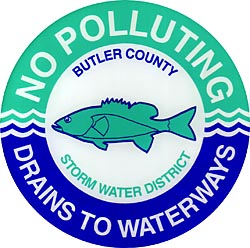
What is Storm Drain Labeling? You can help protect our local streams, lakes, and wetlands. Butler County needs volunteers to tag storm drains with a marker that says “No Polluting , Drains To Local Waterways.” Storm drain labeling is a great community action project that raises public awareness about the importance of keeping surface water clean and helps to significantly reduce surface water pollution.
Everything you will need is provided free of charge. Volunteer groups can stencil in their own neighborhood or ask for maps and a chosen location. E-mail butlerswcd@butlercountyohio.org or call 513-887-3720 for more information about volunteering to stencil storm drains, or look at the topics below.
Who Can Participate?
- Families: Storm Drain Labeling is a great family outing that teaches community involvement and helps the natural environment.
- Homeowner Associations: Labeling the storm drains in your subdivision can help protect nearby rivers and ponds that you and your neighbors enjoy.
- School Groups: Classrooms can stencil the storm drains near their school as part of a water cycle unit.
- Scouting Groups: Boy and Girl Scouts can do Storm Drain labeling with their troop as a service project.
- Service Organizations: Storm Drain Labeling is great for Kiwanis, Rotary, Garden, Women’s, Men’s and other adult clubs looking for community service projects.
- Anyone else that is interested!: Contact us and we can suggest a location.
How Simple is it to Tag a Drain?
Contact Lynn White at the Butler Soil and Water Conservation District at 513-785-6666 for resources and to choose a location and date to do the storm drain tagging. On the day of the event follow these simple steps:
- Using a wire brush, scrub the area of the storm drain that you plan to stick the marker on. Then dust the area clean.
- Create a spiral shape on the back of the marker with the glue that is provided.
- Stick to storm drain by pressing firmly.
Why is Storm Drain Labeling Important?
Storm drains connect your property directly to nearby waterways. Living on a city street is like living right on the waterfront. Everything that washes down a storm drain from a yard or street winds up in local lakes, rivers or streams – not the sewage treatment plant.
Many people think that water pollution is mostly caused by big business or large government facilities-places with pipes leading into the river. These are known as “point source” polluters. However, in recent years these sources have greatly reduced their negative impact on water quality. As a result, storm water run -off is now one of the leading causes of surface water pollution.
In comparison to big facilities with identifiable pipes (“point-source” polluters), run-off is a “non-point” source of pollution. That is, the ultimate source of the pollution cannot be identified. These pollutants are used on lawns, left on driveways and roads, and allowed to go down gutters into storm drains.
Pollutants that come from “non-point” sources include:
- Street litter
- Pet wastes and other debris
- Fertilizers, pesticides, herbicides, yard waste and other lawn care residues
- Motor oil, gasoline, transmission fluid, anti-freeze and other substances that leak from cars onto driveways and parking lots.
Storm water pollution is also caused by illegal dumping, like pouring paint or oil into a storm drain. In fact, just one quart of motor oil can pollute 250,000 gallons of water!
As part of Phase II of the Clean Water Act, cities, townships and municipalities are asked to monitor and control the pollution that is released to waterways and ground water. The Environmental Protection Agency (EPA) recommends labeling (tagging) under the new Phase II Storm Water Rule requirements for Public Education and Outreach, Public Participation/Involvement and Illicit discharge detection & elimination.